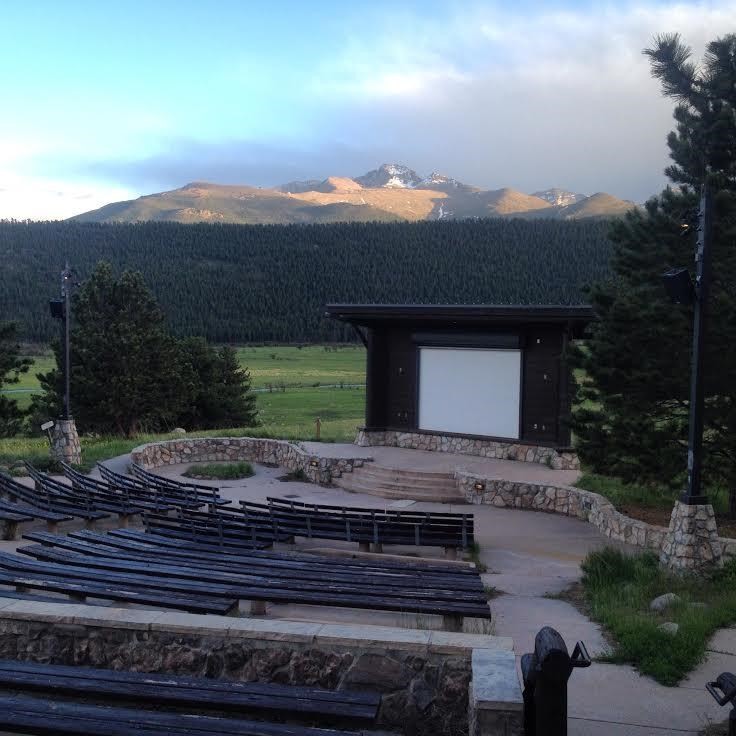Moraine Park and Judge Florence Allen
Introduction
Text-to-speech Audio
Moraine Park is one of the more well-known areas of Rocky Mountain National Park. Many people know Moraine Park today as a popular campground for visitors to the National Park. Moraine Park is the only campground in Rocky Mountain National Park that is open year-round. Nearby the campground, several cabins stand starkly among the natural scenery. One of these cabins belonged to Judge Florence Allen of Ohio. Judge Allen summered in Moraine Park for many years with her partner Mary Pierce. She described her life in Moraine Park as “hectic but satisfactory.”
Images
Moraine Park Campground Amphitheater

Judge Florence Allen

Backstory and Context
Text-to-speech Audio
Florence Ellinwood Allen was born in Utah on March 23, 1884. Her father moved the family to Cleveland, Ohio for a job as a linguist at Case Western Reserve University, and Florence spent her teenage years there. She later attended Case Western Reserve herself, graduating in 1904. After this, she traveled to Germany to study music. Florence returned to the United States, studying Constitutional Law at Case Western, graduating with a Master's Degree in 1908. From there, Florence entered law school at the University of Chicago Law, due to Case Western not accepting women at the time she applied. She only stayed at the University of Chicago for one year before transferring to New York University in New York City. During this time she acquainted herself with the suffragette movement, becoming an active member and advocate. Florence Allen graduated from law school in 1913 and returned to Ohio to set up her law practice.
Florence Allen championed herself as an advocate for women’s rights and suffrage. Prior to women receiving national suffrage, she obtained a position as a prosecutor in Ohio, making her the first woman prosecutor in the state. After the passing of the nineteenth amendment, which gave women the right to vote in elections, she rallied up her suffragette supporters and ran for the Ohio Supreme Court in 1922, winning by five thousand votes. Judge Allen became the first woman judge to rise to the Ohio Supreme Court, as well as the first woman judge to sit on the bench for any state supreme court. Judge Allen’s next achievement would again leave her legacy as a trailblazer in the United States judicial system. A lifelong Democrat, the Roosevelt administration thought her to be a good candidate for a nomination for the Sixth District Court of Appeals. While she aspired for the highest court, the nomination never came, though allegedly she was on the shortlist during the Truman and Eisenhower administrations. The first woman on the United States Supreme Court would be Sandra Day O’Conner in 1981, just fifteen years after Judge Allen passed away. While she never saw a woman sit on the highest bench, she certainly knew her significance as a pioneer for women in the legal profession and elsewhere, as she had many admirers and mentees.
Judge Allen spent much of her professional life in Ohio. In her downtime, she liked to be outside. The freedom of the outdoors appealed to her, especially the West. It was through her love of the outdoors that she purchased a cabin in Moraine Park, up in the Rocky Mountains, in 1927. She purchased this property with a woman that she lived with, known as Mary Pierce. Mary Pierce was referred to as Judge Allen’s “distant cousin,” in public, though no familiar relation is known. Neither woman married, but the two lived with each other until Allen’s death in 1966. Mary Pierce and Judge Allen share a grave plot together in Ohio. The little family in the cabin in Moraine Park consisted of Mary, Florence, and their two dogs. The women spent time fishing, hiking, and gardening in their little patch of paradise. These two women clearly felt a deep connection to the place and each other, with Florence remarking that life in Moraine Park was, “hectic but satisfactory,” when comparing it to her life as a federal judge in Ohio. Mary and Florence built an addition onto their cabin, expanding and caring for their property for the next twenty-six years until age prevented them from doing so any longer and they sold their beloved cabin.
The Florence Allen of Estes Park and her public-facing persona, Judge Allen, shattered the restraints of her gender in her private and public life. Throughout her career and private life, she showed dedication to the causes and people she loved. The summers she spent with Mary Pierce up in Estes Park show the freedom that the mountains gave these women to shed the boundaries of masculinity and femininity, mixing the rugged outdoors with the pleasure of leisure, in a space to care for, enjoy, and love each other. The cabin provided a space away from the constraints of gender roles, something that Florence Allen seemed to break from throughout her entire life, with the little cabin in Moraine Park standing as evidence of this.
Cite This Entry
History 640, CSU. "Moraine Park and Judge Florence Allen." Clio: Your Guide to History. December 10, 2022. Accessed April 11, 2025. https://theclio.com/entry/160554
Sources
Cheri Yost, “A Woman of Firsts: Judge Florence Allen.” https://www.nps.gov/romo/woman_of_firsts.htm.
“Florence E. Allen,” https://ohiohistorycentral.org/w/Florence_E._Allen.
“Florence Ellinwood Allen: The First Woman State Supreme Court Justice,” https://www.brennancenter.org/our-work/analysis-opinion/florence-ellinwood-allen-first-woman-state-supreme-court-justice.
Joan Organ, “Florence Allen Lecture,” Estes Park, October 22, 2022.
“Post Office Grows with Community.” The Estes Park Trail, April 23, 1937.
https://www.nps.gov/romo/planyourvisit/mpcg.htm
https://en.wikipedia.org/wiki/Florence_E._Allen

